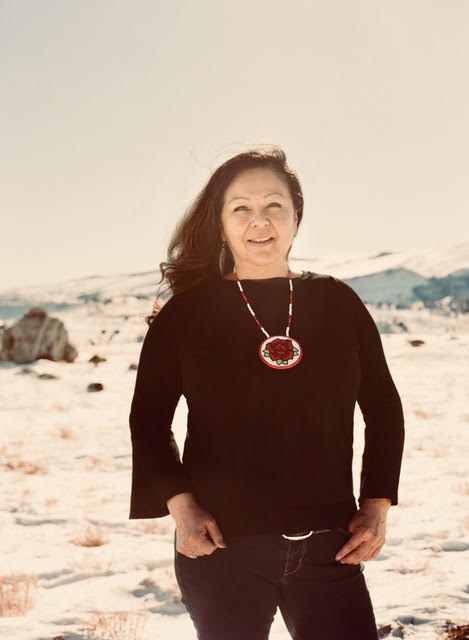Part of what makes Wyoming such a culturally rich destination is its Native American heritage, both past and present. Wyoming is home to two tribes – the Northern Arapaho and Eastern Shoshone – which have members working to preserve and carry forward culturally significant aspects of their communities.
We had the opportunity to ask Lynette St. Clair, Shoshone linguist, cultural preservationist & education consultant on the Wind River Reservation, about her life growing up on the Wind River Reservation and her efforts to preserve the Shoshone language.

Tell us a little about yourself.
I reside on the Wind River Reservation in Wyoming, where I attended schools in Fort Washakie and Lander. I attended college at Montana State University-Billings where I received my BS in Public Relations. I went on to attend Southeastern Oklahoma State University, where I graduated with my Master of Science Degree in Native American Leadership. I am an advocate for our indigenous communities and have made the preservation of the Shoshone language and history one of the main priorities in my career.
How have your life experiences as an indigenous woman shaped who you are today?
I feel blessed to have been raised in the family to which I belong. Our way of life is unique in that from a very young age to when we become older, we are taught that we must be thankful for all that we have and give thanks for those blessings. We are also taught to respect who we are and where we come from. These lessons are intertwined daily with everyday tasks of life. I believe that these practices have helped shape who I am today.
I also think that my involvement in the education field is because of these experiences. When I was younger, the majority of the people within the schools I attended, my teachers, were not the same as me. There were very few tribal teachers, and those who were Shoshone or Arapaho or members of other tribes were support staff. I respect that, but I also think there’s always room for growth. I started out in the school system as the school secretary and eventually became a teacher and then an administrator. I want to show our students that through hard work, dedication, and the right support, they can reach their goals.
How did you first learn the Shoshone language?
I grew up immersed in the language. My mother and father both spoke Shoshone fluently and in the home. My grandparents, siblings, aunties and uncles also spoke. So it was from within this natural, linguistic environment that I learned.
Over your lifetime, has the use of the Shoshone language become more or less prevalent?
When I grew up in the ’70s and ’80s, many people in my community spoke Shoshone. It wasn’t until the later years, the ’90s and 2000s, where I saw a definite decline in the use of our language. The older generations (people from the 60-90 year range) were the only people speaking the language. Presently, there are fewer than 100 fluent language speakers.
Can you describe the importance of preserving the Shoshone language?
Our language is who we are. Without it, we will be lost. This was told to me by my uncle Starr Weed Sr. I believe it. The language is attached to everything indigenous: our spirituality, our ways of living, our very existence. It’s in everything we do. We can’t have a ceremony if we don’t speak the language and we can’t carry on our stories, history, or ways of doing things if we don’t know our language. This is what I see that is missing in our youth, which is why it’s critical that we preserve our language. To center our people. To bring them full circle and to carry it forward for the next seven generations.
Can you tell us a little about your app, Newe Daygwap, and how you hope for it to work as a tool to learn about the Shoshone language and culture?
Right now we are working on ways to use it as a classroom resource for language learning. The pandemic has accelerated our efforts in doing this and we have had to get creative with instruction. In addition to our language app, we are also using Quizlet and Kahoot to teach the Shoshone language as well as history.
What inspired you to go into education?
I want to help inspire our youth to be proud of who they are and where they come from. By being in education, I want to be a voice for our students and the community. Although I left for a five-year period, I returned to continue the work that I set out to do. By doing this I am demonstrating to them that they can achieve big things if they stay the course.
What would you like people to know when visiting the Wind River Indian Reservation?
I want people to understand that our reservation is one of the most beautiful places on earth! Our community welcomes visitors but also want you to understand that there are some traditions and customs that we wish to retain and is not for public knowledge.
If you want to take a quick journey through the Shoshone portion of the reservation, take a virtual tour through TravelStorys. Our high school students created this tour to help introduce visitors to our reservation. We are currently working on Phase II, which will introduce travelers to the eastern portion of the reservation and more about the Northern Arapaho.
Where is your favorite place to visit in Wyoming?
I have many places that I love in Wyoming but would have to say the Wind River mountain range is my favorite. The beautiful trees, natural formations and lakes are unmatched in beauty. I also like the Togwotee pass area, especially in the fall.